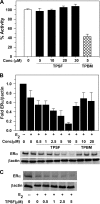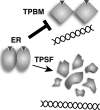A noncompetitive small molecule inhibitor of estrogen-regulated gene expression and breast cancer cell growth that enhances proteasome-dependent degradation of estrogen receptor {alpha}
- PMID: 21041310
- PMCID: PMC3009914
- DOI: 10.1074/jbc.M110.183723
A noncompetitive small molecule inhibitor of estrogen-regulated gene expression and breast cancer cell growth that enhances proteasome-dependent degradation of estrogen receptor {alpha}
Abstract
The mechanisms responsible for 17β-estradiol (E(2))-stimulated breast cancer growth and development of resistance to tamoxifen and other estrogen receptor α (ERα) antagonists are not fully understood. We describe a new tool for dissecting ERα action in breast cancer, p-fluoro-4-(1,2,3,6,-tetrahydro-1,3-dimethyl-2-oxo-6-thionpurin-8-ylthio) (TPSF), a potent small-molecule inhibitor of estrogen receptor α that does not compete with estrogen for binding to ERα. TPSF noncompetitively inhibits estrogen-dependent ERα-mediated gene expression with little inhibition of transcriptional activity by NF-κB or the androgen or glucocorticoid receptor. TPSF inhibits E(2)-ERα-mediated induction of the proteinase inhibitor 9 gene, which is activated by ERα binding to estrogen response element DNA, and the cyclin D1 gene, which is induced by tethering ERα to other DNA-bound proteins. TPSF inhibits anchorage-dependent and anchorage-independent E(2)-ERα-stimulated growth of MCF-7 cells but does not inhibit growth of ER-negative MDA-MB-231 breast cancer cells. TPSF also inhibits ERα-dependent growth in three cellular models for tamoxifen resistance; that is, 4-hydroxytamoxifen-stimulated MCF7ERαHA cells that overexpress ERα, fully tamoxifen-resistant BT474 cells that have amplified HER-2 and AIB1, and partially tamoxifen-resistant ZR-75 cells. TPSF reduces ERα protein levels in MCF-7 cells and several other cell lines without altering ERα mRNA levels. The proteasome inhibitor MG132 abolished down-regulation of ERα by TPSF. Thus, TPSF affects receptor levels at least in part due to its ability to enhance proteasome-dependent degradation of ERα. TPSF represents a novel class of ER inhibitor with significant clinical potential.
Figures

 O and fluorine substitutions at the phenyl ring. B, shown are potency and efficacy of TPSF (triangles), TPBM (squares), and 99676 (circles). Inhibition of E2-ERα activation of ERE-Luc was evaluated in dose-response studies of T47D (ERE)3-Luc cells maintained in 0.2 n
O and fluorine substitutions at the phenyl ring. B, shown are potency and efficacy of TPSF (triangles), TPBM (squares), and 99676 (circles). Inhibition of E2-ERα activation of ERE-Luc was evaluated in dose-response studies of T47D (ERE)3-Luc cells maintained in 0.2 n








Similar articles
-
Transcriptional regulation of vascular endothelial growth factor by estradiol and tamoxifen in breast cancer cells: a complex interplay between estrogen receptors alpha and beta.Cancer Res. 2002 Sep 1;62(17):4977-84. Cancer Res. 2002. PMID: 12208749
-
A new small molecule inhibitor of estrogen receptor alpha binding to estrogen response elements blocks estrogen-dependent growth of cancer cells.J Biol Chem. 2008 May 9;283(19):12819-30. doi: 10.1074/jbc.M709936200. Epub 2008 Mar 12. J Biol Chem. 2008. PMID: 18337247 Free PMC article.
-
Histone deacetylase inhibitor trichostatin A represses estrogen receptor alpha-dependent transcription and promotes proteasomal degradation of cyclin D1 in human breast carcinoma cell lines.Clin Cancer Res. 2004 Dec 1;10(23):8094-104. doi: 10.1158/1078-0432.CCR-04-1023. Clin Cancer Res. 2004. PMID: 15585645
-
Computer-Aided Ligand Discovery for Estrogen Receptor Alpha.Int J Mol Sci. 2020 Jun 12;21(12):4193. doi: 10.3390/ijms21124193. Int J Mol Sci. 2020. PMID: 32545494 Free PMC article. Review.
-
Novel Breast Cancer Treatment by Targeting Estrogen Receptor-Alpha Stability Using Proteolysis-Targeting Chimeras (PROTACs) Technology.In: Mayrovitz HN, editor. Breast Cancer [Internet]. Brisbane (AU): Exon Publications; 2022 Aug 6. Chapter 12. In: Mayrovitz HN, editor. Breast Cancer [Internet]. Brisbane (AU): Exon Publications; 2022 Aug 6. Chapter 12. PMID: 36122155 Free Books & Documents. Review.
Cited by
-
Estrogen receptor α inhibitor activates the unfolded protein response, blocks protein synthesis, and induces tumor regression.Proc Natl Acad Sci U S A. 2015 Apr 14;112(15):4737-42. doi: 10.1073/pnas.1403685112. Epub 2015 Mar 30. Proc Natl Acad Sci U S A. 2015. PMID: 25825714 Free PMC article.
-
Anticipatory estrogen activation of the unfolded protein response is linked to cell proliferation and poor survival in estrogen receptor α-positive breast cancer.Oncogene. 2015 Jul;34(29):3760-9. doi: 10.1038/onc.2014.292. Epub 2014 Sep 29. Oncogene. 2015. PMID: 25263449 Free PMC article.
-
A competitive inhibitor that reduces recruitment of androgen receptor to androgen-responsive genes.J Biol Chem. 2012 Jul 6;287(28):23368-80. doi: 10.1074/jbc.M112.344671. Epub 2012 May 15. J Biol Chem. 2012. PMID: 22589544 Free PMC article.
-
8-alkylthio-6-thio-substituted theophylline analogues as selective noncompetitive progesterone receptor antagonists.Steroids. 2012 May;77(6):596-601. doi: 10.1016/j.steroids.2012.02.003. Epub 2012 Mar 6. Steroids. 2012. PMID: 22421057 Free PMC article.
-
Melanoma antigen-A11 regulates substrate-specificity of Skp2-mediated protein degradation.Mol Cell Endocrinol. 2017 Jan 5;439:1-9. doi: 10.1016/j.mce.2016.10.006. Epub 2016 Oct 6. Mol Cell Endocrinol. 2017. PMID: 27720894 Free PMC article.
References
-
- O'Lone R., Frith M. C., Karlsson E. K., Hansen U. (2004) Mol. Endocrinol. 18, 1859–1875 - PubMed
-
- Carroll J. S., Brown M. (2006) Mol. Endocrinol. 20, 1707–1714 - PubMed
-
- Carroll J. S., Liu X. S., Brodsky A. S., Li W., Meyer C. A., Szary A. J., Eeckhoute J., Shao W., Hestermann E. V., Geistlinger T. R., Fox E. A., Silver P. A., Brown M. (2005) Cell 122, 33–43 - PubMed
-
- Jakacka M., Ito M., Weiss J., Chien P. Y., Gehm B. D., Jameson J. L. (2001) J. Biol. Chem. 276, 13615–13621 - PubMed
-
- Safe S. (2001) Vitam. Horm. 62, 231–252 - PubMed
Publication types
MeSH terms
Substances
Grants and funding
LinkOut - more resources
Full Text Sources
Medical
Research Materials
Miscellaneous

